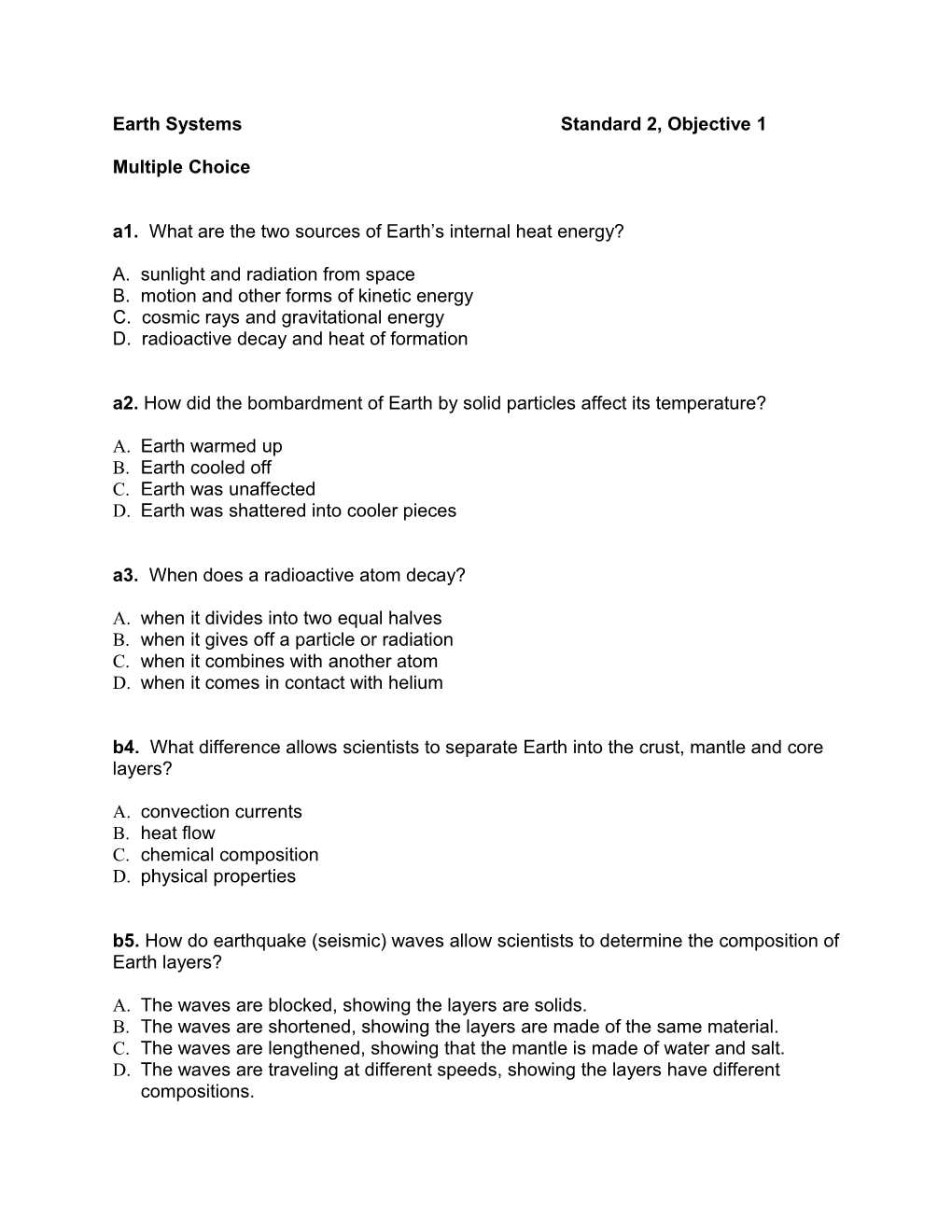Earth SystemsStandard 2, Objective 1
Multiple Choice
a1. What are the two sources of Earth’s internal heat energy?
A. sunlight and radiation from space
B. motion and other forms of kinetic energy
C. cosmic rays and gravitational energy
D. radioactive decay and heat of formation
a2. How did the bombardment of Earth by solid particles affect its temperature?
- Earth warmed up
- Earth cooled off
- Earth was unaffected
- Earth was shattered into cooler pieces
a3. When does a radioactive atom decay?
- when it divides into two equal halves
- when it gives off a particle or radiation
- when it combines with another atom
- when it comes in contact with helium
b4. What difference allows scientists to separate Earth into the crust, mantle and core layers?
- convection currents
- heat flow
- chemical composition
- physical properties
b5. How do earthquake (seismic) waves allow scientists to determine the composition of Earth layers?
- The waves areblocked, showing the layers are solids.
- The waves are shortened, showing the layers are made of the same material.
- The waves are lengthened, showing that the mantle is made of water and salt.
- The waves are traveling at different speeds,showing the layers have different compositions.
b6. Why must scientists infer the composition of Earth’s layers?
- There is no evidence to support a theory.
- They cannot gather samples from the layers.
- Scientists do not agree on the layers of Earth.
- The layers vary from one part of Earth to another.
b7. What substances must Earth’s core be composed of to create the magnetic field and density needed to match estimates of Earth’s mass?
- aluminum and copper
- iron and nickel
- magnesium and carbon
- sulfur and potassium
b8. Why would the composition of a meteorite resemble the Earth’s interior?
- They were both formed from the same nebula.
- Meteorites were once part of Earth.
- All materials from space share the same materials.
- Traveling through the atmosphere alters the meteorite.
c9. How are Earth’s lithosphere and asthenosphere different from one another?
- They have different physical properties.
- They have different chemical composition.
- They were formed during different time periods.
- The lithosphere does not allow seismic waves to travel through.
c10. What do seismic waves indicate about the physical properties of the asthenosphere?
- It has a high temperature.
- It has convection currents.
- It is made of less dense rocks.
- It is more fluid than the lithosphere.
c11. Why are the properties of the asthenosphere important to plate tectonics theory?
- A fluid asthenosphere allows the plates to move.
- The plates are held in place by the asthenosphere.
- The depth of the asthenosphere gives plates room to sink
- The properties show that plate tectonics must be a correct theory.
c12. What direct evidence do scientists have concerning the properties of the asthenosphere?
- Dense rock samples come from drill holes in the asthenosphere.
- Lightweight crustal rocks are from the asthenosphere.
- Heat from volcanic lava comes from near the asthenosphere.
- Continents must be floating on a fluid layer or they could not move.
d13. What is the movement of heated materials upward and the movement of cooled materials downward called?
- Convection
- Coriolis Effect
- Contraction
- Climate
d14. How do scientists explain the movement of Earth’s tectonic plates?
A. They are floating in the oceans and move randomly.
B. They move when volcanoes erupt and earthquake faults slip.
C. They move when heat creates convection currents in Earth’s mantle.
D. The spinning of Earth gives the plates energy to move the continents.
Use this description of an experiment to answer the next three questions.
Students ask if convection currents are strong enough to move heavy objects. They use a fish tank and a toy boat that floats. Then they place the boat in the tank and watch it for 10 minutes. It doesn’t move. Next they put a hot plate under one side of the fish tank and turn it on. They watch for a half hour, and at the end of that time, the boat has moved across the aquarium away from the heat.
d15. What is a flaw in the experimental design of this experiment?
A. The toy boat should have enough weight to sink.
B. The hot plate should have been used in the first test.
C. The fish tank should have been filled with different liquids.
D. The amount of time should have been the same for both tests.
d16. Why did the boat move away from the heat?
- It was just a chance occurrence.
- The hot water acted like a fuel for the boat.
- The boat was moving on a convection current.
- Hot water repels other substances, cold water attracts.
d17. Which diagram shows the movement that affected the boat? The hot plate is shown in black.
On your Answer Sheet answer the last 2 questions.
1. Draw and explain what forces drive a convection current. In your description be sure to include density and temperature.
2. Describe the properties and the location of the asthenosphere.
